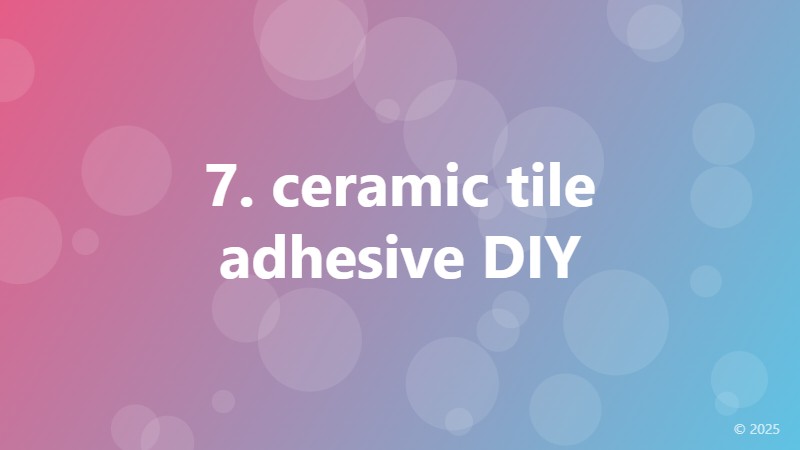7. ceramic tile adhesive DIY

Why Choose Ceramic Tile Adhesive DIY: Benefits and Advantages
When it comes to ceramic tile installation, one of the most critical components is the adhesive. A good ceramic tile adhesive can make all the difference in the overall appearance and durability of your tile project. While there are many commercial ceramic tile adhesives available in the market, a DIY approach can be a cost-effective and fulfilling alternative. In this article, we will explore the benefits and advantages of choosing a ceramic tile adhesive DIY approach.
What is Ceramic Tile Adhesive?
Ceramic tile adhesive, also known as tile glue or tile cement, is a specialized adhesive used to bond ceramic tiles to a surface. It is a critical component in tile installation, as it ensures a strong and durable bond between the tile and the substrate. Ceramic tile adhesive is available in different types, including epoxy-based, acrylic-based, and cement-based adhesives.
Benefits of Ceramic Tile Adhesive DIY
There are several benefits to choosing a ceramic tile adhesive DIY approach. Some of the advantages include:
Cost-effective: DIY ceramic tile adhesive can be a cost-effective alternative to commercial adhesives.
Customization: With a DIY approach, you can customize the adhesive to suit your specific tile project needs.
Environmentally friendly: DIY ceramic tile adhesive can be made using eco-friendly materials, making it a more sustainable option.
Flexibility: A DIY approach allows you to adjust the adhesive formula to suit different tile types and substrate materials.
7 Ceramic Tile Adhesive DIY Recipes to Try
If you're interested in trying a ceramic tile adhesive DIY approach, here are 7 recipes you can try:
Recipe 1: Epoxy-based adhesive using resin and hardener
Recipe 2: Acrylic-based adhesive using white glue and water
Recipe 3: Cement-based adhesive using Portland cement and sand
Recipe 4: Natural adhesive using lime putty and water
Recipe 5: Polyurethane-based adhesive using polyurethane foam and hardener
Recipe 6: Silicone-based adhesive using silicone caulk and catalyst
Recipe 7: Hybrid adhesive using a combination of epoxy and acrylic resins
Tips and Precautions for Ceramic Tile Adhesive DIY
While a DIY approach can be a cost-effective and fulfilling alternative, it's essential to follow proper preparation and application techniques to ensure a strong and durable bond. Here are some tips and precautions to keep in mind:
Always follow the recipe instructions carefully to ensure the correct ratio of ingredients.
Make sure the substrate surface is clean, dry, and free of dust and debris.
Apply the adhesive according to the manufacturer's instructions or recipe guidelines.
Allow the adhesive to cure according to the instructions or recipe guidelines.
By following these tips and precautions, you can ensure a successful ceramic tile adhesive DIY project that will last for years to come.